Eight members of the Tokyo Tech teaching staff and associates received the Commendation for Science and Technology by the Minister of Education, Culture, Sports, Science and Technology (MEXT) for their outstanding achievements in the field of science and technology.
The Commendation for Science and Technology by the Minister of Education, Culture, Sports, Science and Technology is awarded for research in several areas including the "Development Category," "Research Category," and "Understanding Enhancement Category." This year's recipients included three Institute associates whose research activities and achievements have been highly praised.
In addition, the "Young Scientist Award," given to young researchers who conduct exploratory or unique research, and whose results showcase advanced research development ability, was awarded to five members of the Tokyo Tech teaching staff.
Technology Award (Research Category)
Honorary Professor Takao Ikariya
Award-Winning Work: "Development of an Innovative, Practical-Use Molecular Catalyst and Application Research for Precise Synthetic Chemistry"
Comment by Honorary Professor Takao Ikariya
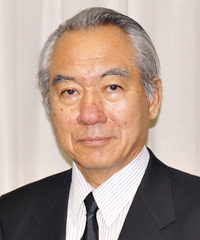
Honorary Professor Takao Ikariya
I am very honored to receive this Commendation for Science and Technology by the Minister of Education, Culture, Sports, Science and Technology. I have been striving to establish a "Manufacturing Chemistry/Technology" that can help reduce the burden on the environment through my research of high-efficiency molecular conversion reaction using a concerto molecular catalyst based on organic metallic compounds, and of supercritical carbon dioxide catalyst reaction. This achievement is the result of the work by my joint researchers and students, and is beyond my expectations. I thank you from my heart.
Professor Shin-ya Koshihara
Department of Chemistry and Materials Science, Graduate School of Science and Engineering
Award-Winning Work: "Experimental Research Related to Photo-Induced Phase Transition and Related Phenomena"
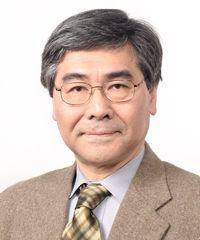
Professor Shin-ya Koshihara
Comment by Professor Shin-ya Koshihara
I would like to show my appreciation for this prestigious award for my research on photo-induced phase transition. I would like to thank everyone who contributed, especially the young people. My desire is to pioneer an exciting intellectual world using research and education as the vehicle.
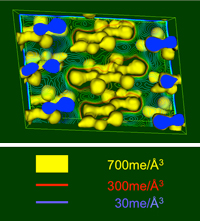
Image of electron density distribution at the ionic phase for a charge-transfer complex tetrathiafulvalene-chloranil crystal that indicates the photo-induced phase transition where the neutral molecular crystal (neutral phase) and ion crystal status (ion phase) are exchanged (acquired from results of X-ray structure refinement analysis)
Technology Award (Understanding Enhancement Category)
Etsuhiko Shoyama
Administrative Director of the Tokyo Tech Alumni Association
Award-Winning Work: "Enhancing Children's Understanding through an Experiment Participation Type Terakoya Style Delivery Science Class"
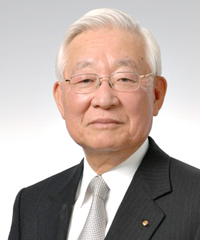
Administrative Director Etsuhiko Shoyama
Comment by Administrative Director Shoyama
Receiving the Commendation for "Kurarika," which has been promoted by the Tokyo Tech Alumni Association, means the hard work done by those involved and the importance of supporting science education in elementary and junior-high schools has received due recognition. I am very grateful and would like to increase the promotion of science among children and contribute to the building of a creative nation in science and technology.
Young Scientists Award
Tenure Track Associate Professor Tsuyoshi Yoneda
Department of Mathematics, Graduate School of Science and Engineering
Award-Winning Work: "Research on Fluid Equations Focusing on Real Analysis Techniques"
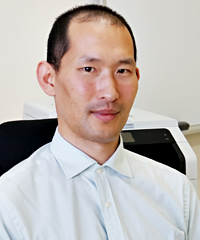
Associate Professor Tsuyoshi Yoneda
Comment by Associate Professor Yoneda
I am very honored to receive such a prestigious award which motivates me to continue my research. I would like to take this opportunity to show my appreciation to everyone who has supported me up until now.
I am studying Navier–Stokes equations, which are equations used for expressing the movement of fluids mathematically. The Navier–Stokes equations are very important and offer one of the famous "Millennium Prize Problems." Recently, I have used various approaches such as differential geometry, numerical calculation, and fluid physics (theoretical physics) in addition to analyses (functional analysis and Fourier analysis) traditionally used in the Navier–Stokes research field. In the future, I would like to deepen exchange between diverse fields such as engineering science, chemistry, and life science.
Assistant Professor Satoru Fujiyoshi
Department of Physics, Graduate School of Science and Engineering
Award-Winning Work: "Research on Single Protein Spectroscopy at a Temperature of a few K"
Comment by Assistant Professor Fujiyoshi
It would have been impossible to accomplish this research without the craftsmanship of the people at Vacuum and Optical Instruments, the small local factories in Ota-Ku including Ono Seiko Seisakusho, and those at Sankyo Optical Industry Factories in Akita Prefecture, to whom I would like to show my appreciation. I would also like to thank Mr. Michio Matsushita, Mr. Masahiro Kotani, and Mr. Tadamasa Shida who helped guide me, to Dr. Hiroyuki Koikawa, Mr. Taro Kato, Mr. Sou Hoshino, Dr. Daisuke Uchiyama, Mr. Kim Shoman, Mr. Kenichi Onda, Mr. Ei Watanabe, Dr. Masanori Fujiwara, Mr. Yo Furuya, Mr. Mitsuharu Hirano, Mr. Tatsuya Yoshihiro, Mr. Atsunori Sakurai, Mr. Hiroyuki Yamakawa, Mr. Satoshi Ueda, Mr. Ippei Nakamura, Mr. Akari Shimauchi, Mr. Takuya Hinohara, Mr. Subaru Okamoto, Ms. Minako Maruo, Dr. Kohei Otomo, Mr. Hironori Inagawa, Mr. Hironori Hamada, Dr. Toru Kondo, Mr. Yasuharu Toratani, Mr. Keisuke Wakao, Mr. Kazuya Motohashi, Mr. Tomotaka Mori, and Mr. Takaya Naito who participated in experiments, and to Mr. Masakatsu Watanabe and Mr. Mineo Iseki from The Graduate University for Advanced Studies, Mr. Mamoru Nango and Mr. Takehisa Dewa from the Nagoya Institute of Technology, Mr. Nobuhiro Hayashi of the Tokyo Institute of Technology, Graduate School of Bioscience and Biotechnology, Mr. Takamitsu Hosoya from the Tokyo Medical and Dental University, and to Mr. Isao Kii from Kyoto University who collaborated in this research.
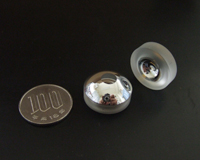
The photo shows the reflective objective lens which operates at extremely low temperatures. For size comparison, there is a 100 yen coin to the left of the two lenses.
Associate Professor Masashi Sugiyama
Department of Computer Science, Graduate School of Information Science and Engineering
Award-Winning Work: "Pioneering Research on Next-Generation Machine Learning Techniques Supporting the Age of Big Data"
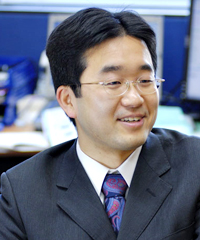
Associate Professor Masashi Sugiyama
Comment by Associate Professor Sugiyama
The age of big data has arrived, where a large amount of information can be acquired through the Internet and sensors. It is expected that this will create new value in various fields from basic science to engineering applications. However, big data with high dimensionality and complex structure is difficult to analyze accurately using existing information technology.
Based on this, I showed that various intellectual information processing problems can bring probability density ratio estimation problems, and developed an extremely fast and accurate estimation method for probability density ratio. As a result, various machine learning problems including malfunction detection, pattern recognition, feature extraction, and clustering can be unified and accurately solved.
Receiving this award encourages me to work toward establishing an information processing technology foundation that can support big data. I appreciate the efforts of everyone who collaborated with me and the Computer Science teaching staff who provided an excellent research environment, and I would also like to ask for their future support.
Assistant Professor Tetsuo Kodera
Quantum Nanoelectronics Research Center
Award-Winning Work: "Research Related to the Spins in Semiconductor Quantum Nanostructures"
Comment by Assistant Professor Kodera
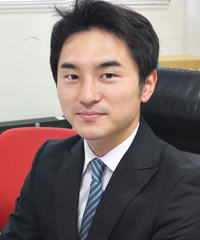
Assistant Professor Tetsuo Kodera
I have studied the technologies and physics of new principle devices that utilize the spins in semiconductor quantum nanostructures for information application. This is expected to improve the performance of electronic devices while reducing power consumption, and becomes a key element in quantum computers. It is an honor to receive this prize. I want to express my sincere gratitude to my supervisors who guided me, to all the researchers who have worked with me, and all members in the laboratory. I aim to continue my efforts in this area of research.
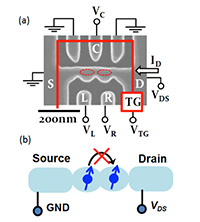
Figure.
(a) Scanning electron microscope image of a silicon quantum dot device
(b) Schematic diagram of spin-related tunneling phenomenon
Specially Appointed Associate Professor Hitoshi Nakatogawa
Frontier Research Center
Award-Winning Work: "Research on the Molecular Mechanism that Drives Autophagy"
Comment by Specially Appointed Associate Professor Nakatogawa
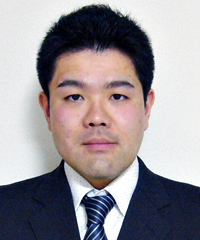
Associate Professor Hitoshi Nakatogawa
Autophagy is a large-scale decomposition/recycling system that takes place in the cells that make up our bodies. The autophagy mechanism is rather mysterious, so I work on trying to understand it. Receiving this award makes me appreciate the instructors who helped me, my colleagues, and the students who participated in the research. I will continue to work hard in order to solve the mystery of autophagy.

Through autophagy, targets for decomposition are wrapped in a membrane called autophagosome, then transferred to a location for decomposition such as the lysosome or vacuole. As shown in this diagram, the autophagosome membrane is created through a very unique and dynamic process. Our research resulted in important findings for understanding the mechanism that drives this membrane formation.
. Any information published on this site will be valid in relation to Science Tokyo.













